Rating: 5 out of 5





The last words of Lieutenant Colonel Nicholson after he realizes the totality of his actions the last few minutes of the film were, “What have I done?” You know what you actually did? You don f**ked up! That’s what you did.
I picked up The Bridge on the River Kwai as something to watch during one of my long weekends. I was intrigued by the film because it was highly regarded in the film world. I’ve only heard about it through many best movie lists. AFI, American Film Institute, ranked the film #13 for their first top 100 movies, #58 in 100 Thrills, #14 in 100 Cheers, and when they redid their top 100 movies, it was ranked again at #36. Hell, The British Film Institute placed the film as the 11th greatest British film. High accolades for a film that also won seven Academy Awards, including Best Picture and Best Actor.
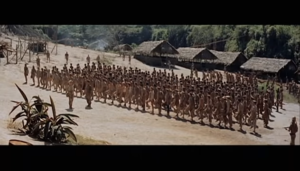
The film is set during World War II in the early parts of 1943. The Japanese have a P.O.W camp on an island near the River Kwai. The primary reason for the camp is for the Japanese to use the labor of the P.O.W.s and construct a railway bridge over the river. The Japanese believe this is a vital link and position for their forces. Colonel Saito (Hayakawa) is ordered to complete the bridge in five months on the exact date of May 12th. If not completed, Colonel Saito must commit a ritual suicide for his failure. With the pressure from his superiors, Saito controls his prisoners with strenuous labor and torture. The camp is run by a mixture of Japanese cultural tradition and the need to win the war at any cost. Saito’s beliefs, along with the camp, is soon challenged when Lieutenant Colonel Nicholson (Guinness), a senior British officer, along with new prisoners arrive. The two men quickly become at odds and oppose each other on how things should be run along with the building of the bridge. As cultures collide, will the two be able to work out their differences and build the bridge on time?
When I first started watching this movie, I thought it was going to be about two forces fighting over a bridge. You know the one. The one where either one group needs to protect the bridge at all costs or needs to destroy it to make sure reinforcements don’t come. Well, I was completely wrong on it. It was actually not a war film that I was expecting. It was a film that dealt with being prisoners and building a bridge. Don’t see that theme too often, but yet it was a great film to watch.
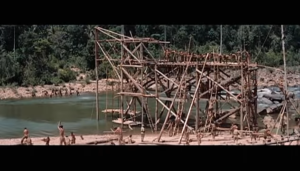
The central theme is building the bridge but mostly the private war between Saito and Nicholson. This is what happens when two cultures, along with PRIDE, come into the way. When Nicholson and his crew roll up in the camp, Saito orders everyone, including officers, that they must help build the bridge. Nicholson, a stickler for the rules, says AWW HELL NAW and argues with Saito. Now, Saito didn’t have to slap the man. SO DISRESPECTFUL! This is where everything goes to hell for both prideful men.
Nicholson gets thrown into the Hot Box after refusing to have him and his officers work. This shows that British pride to the fullest. The man was in the hot box for so long that he comes out looking pale as a ghost and skinny. He is showered by cheers and applaud by his very men. Someone needed to get that man a Gatorade and a sandwich first.
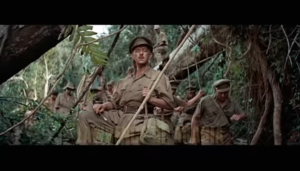
Now, this is where one man’s pride rote to extreme levels, and the other fell hard. Knowing that he won against Saito, Nicholson becomes pretty much a d**k and seems to take control of the prison camp. He walks around and looks at the bridge that is being built along with the men that are building it. His pride and obsession with building a better bridge. Now, I don’t know about you, but if I was a prisoner and had to build a bridge, you bet you’re a** I’m not putting full effort into it. Why would I help the enemy? Yet this is what Nicholson does. He devotes himself to Saito’s project as if it was orders given to him by the British government. He suggests a better site for the bridge, has his men build blueprints and a faster timetable. He even strolls into the hospital to searches for men to help all in his obsession but the British Crown. Then when the bridge is all done, he puts up a sign saying, “designed and built by soldiers of the British army.” Naw dawg, that was all you and your pride.
This is what is irritating about the film. This man doesn’t see that he is HELPING the enemy. You are HELPING him against the British Crown. When confronted by it, he simply states, “War prisoners must work when ordered, and besides, they are setting an example of British efficiency. One day the war will be over, and I hope the people who use this bridge in years to come will remember how it was built and who built it.” Man, ain’t no one going to love your bridge if your side lost.
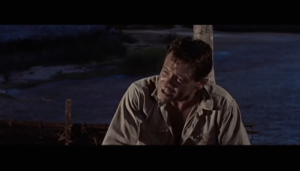
Now the other side of this film is the American Shears. Dude was working in the camp for a little too long, and when he saw the arrival of Nicholson and the new prisoners saw his chance. Actually, when he had a meeting with Nicholson and saw the dude wasn’t going to listen, Shears decided to bounce and escape. His story was pretty funny as he ends up on some tropical island beach, chilling and enjoying life. He literally flirts with a nurse and drinks tropical drinks. It must be nice. His world turns upside down when he is recruited again and has to go back in and blow up the bridge. His respond is epic. He says, “Are you crazy?”
The cinematography is impressive in this film. First is when the prisoners first arrive at the camp. You see them walk in as a column of troops, whistling a song. The song is suspect, but I will get to that. Now the image is grand as the camp seems rural but a vast jungle around them. You see, it is not a typical camp as there are few guards and no fences. The jungle is the fence. Another great image is when the bridge is finally completed. You get a wide image of the men walking down the bridge in excitement. An accomplishment that has lifted their spirits.
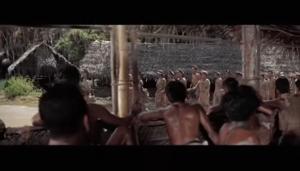
Now I will say this. It was a little strange hearing Colonel Bogey March in this film. Especially when the prisoners first walked into the camp. I always remember that song when I go to Disneyland. I just find it pretty funny that that song was used to march into a sad place. Now I will never be able to listen to that song the same way again.
Out of the whole movie, there really only needs to be two people that are talked about. First, there is Sessue Hayakawa as Colonel Saito. Hayakawa was nominated for the Academy Award for Best Supporting Actor for his role in this movie. Hayakawa embodied Saito as a man built on the tradition of the Japanese culture along with the rules of his country. He is strict, stubborn, but an incredibly proud man.
Overall, this film is carried on the shoulders of Alec Guinness as Lieutenant Colonel Nicholson. Guinness won the Academy Award for Best Actor for his role in this movie. So, he must’ve done something right. Guinness embodies what you would imagine a British WWII officer would be like. He is so dry and seems to lack any humor. He abides by the rules that are set forth by the Geneva Convention. He makes sure all his men resemble a military order even when they are locked up in the middle of a jungle.
The Bridge on the River Kwai is an excellent movie to watch if you are interested in British pride and realizing when you done messed up. Guinness and Hayakawa carry this film as two men bent of maintaining their pride. A great movie to watch with great acting!